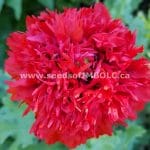The breathtaking beauty and resilience of Papaver somniferum poppies will surround you with joy for years, if not generations, though establishing them is the hardest part.
They will self seed and bring you joy for many years to come.
The poppies listed on my website resent transplanting and do best when direct sown.(although soil blocking has proven successful – just get them planted asap before they get large!)
Keep your seed in the fridge until planting. You can plant them directly into the garden as soon as the soil can be worked in the spring or even if the snow is still around! Poppy seeds require exposure to cool or cold temperatures before they will reliably sprout. They do best in poor soil so sow where the soil has not been amended and choose a sunny spot with good drainage.
Weed the area and rake to a fine tilth. Do not cover, just sprinkle on top of the soil and pat gently to make contact with the soil. Poppies require some light to germinate. Pour some poppy seeds into your hand and sprinkle them very thinly across the ground to create natural looking drifts.(if you have a lot of seed this works)
Sown indoors, their germination rates are much higher and it’s much less weeding.
Start poppy seeds indoors about 8 weeks before final frost and harden off and transplant them about 4 weeks before final frost. They don’t love heat, no need of a heat mat.
I have found that starting poppies in soil blocks works very well, especially if you only have a small amount of precious seed. Lee Valley has soil blockers and they are very easy to use. This way the poppies don’t realize they have been transplanted – be very gentle not to disturb the root system when planting and do it when they are still quite small.

Mist the bed with water daily or as needed so the soil remains moist near the surface until germination. Poppies typically germinate within 15 days if the soil temperature is near 55 F or 12C, but allow 7-30 days to germinate, depending on the variety, soil condition and growing temperatures.
Once the seedlings are large enough to handle, thin them out to around 30cm (6 – 12in) apart. They will repay you with huge, plentiful, healthy blooms.
Slugs love them, so keep an eye out.
Poppies are easy to grow and self-sow with abandon, without becoming weedy. Let them tell you where they want to grow. They will thrive for years at a time in surprising spots, like a crack in the driveway. Other times, they simply won’t take, no matter how much you try. Right plant, right spot.
Keep them moderately well watered in hot, dry weather, and do not fertilize.
If spring and summer are cool and damp, or plants are overcrowded, expect smaller seed heads.
If this all sounds difficult, remember they do it all by themselves once you have them in your garden!
Enjoy!!

Tammy Foss
Hello,
What zone do these poppies grow in?
Thanks,
Tammy
Kat
Hi Tammy! I am in Zone 5 in Ontario. In Zones 3-7, start poppies outdoors in early spring, when some chance of frost is still a possibility. If you live in Zones 8-10, your best bet is to direct sow in the fall.
I hope this helps!
Thank you for your question
Kat
🙂
Judy
Hi Kat: i have an old pond bed that was been mostly back filled with gravel, so it drains well, but it starts out quite wet in the spring.. do poppies handle wet conditions?
Kat
Hi Judy
Unfortunately poppies do not like wet conditions, well drained is great. Best to get them started very early while still quite cool as they don’t do well once it warms up.